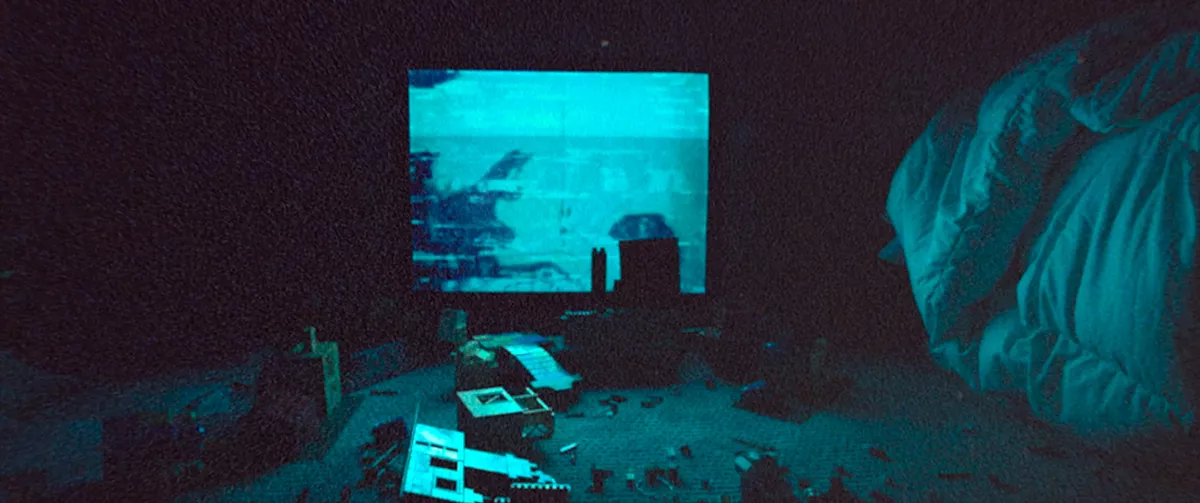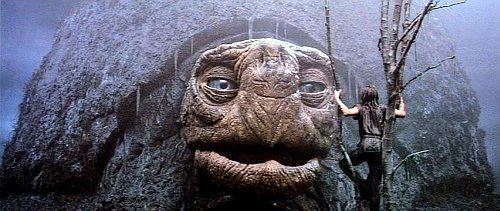Let’s Go Back to Your Childhood (original) (raw)
There are some pretty major SPOILERS for all three of these movies, especially the first two.

Skinamarink – It’s weird, because I wouldn’t necessarily say this was a good movie, but it was pretty effective in what it was trying to do. It’s an experimental film that plays out like a child’s nightmare. It starts with two kids, a six-year-old girl and a four-year-old boy, at home with their father while their mother is away. Not only does their dad disappear, but windows, doors, and other objects start vanishing, and sometimes reappearing in physically impossible places. I can’t recall specifically having any dreams like that, but it seems like the sort of thing that would have frightened me when I was around that age. It was specifically set in 1995, although the appearance of the house and its contents reminded me of my own childhood some years before that. The picture tends to be fuzzy and faded like an old video recording, and a lot of it is in the dark, and you can’t hear everything people say. There are some colorful toys in it, but the movie as a whole has a dull look. As you can probably guess, it’s a very slow burn, with lingering shots of nothing happening eventually leading to a creepy line or image, including a lot of jump scares. The being who’s causing all the chaos is shown at the end as a ghoulish figure, but there’s no indication as to why he’s messing with these kids. Public domain cartoons play on the TV set throughout; I recognized some bits from Small Fry and Bimbo’s Initiation. The song that provided the title, famously performed by Canadian trio Sharon, Lois & Bram, never appeared in the movie itself. At the end, the boy asks the monster’s name, and it doesn’t answer. I thought for a moment that its name would turn out to BE Skinamarink, as malevolent entities with silly names is kind of a tradition, but no. By the way, we saw this at the Nitehawk at Prospect Park, and they’ll often make a collection of old footage that’s somehow related to the film to show before it. In this case, it included Lionel Richie’s “Dancing on the Ceiling” video, because one of the things the evil being does is to move people and objects onto the ceiling.

The Neverending Story – We also saw this one at the Nitehawk. I’ve seen it many times; it was a favorite of mine as a kid. I’d never seen it on the big screen, though. I guess most people didn’t, as it didn’t do that well at the box office, but became more of a hit on video. I believe my first exposure to it was watching a few minutes of the scene with Morla, the giant turtle, when I was about eight.

Beth always cries quite a bit while watching this. I don’t really cry at movies, and I really couldn’t say why. It makes me wonder if there’s something wrong with me. I did eventually read the book it was based on, but I don’t think I wrote anything about it at the time, or at least nothing I can find now. The movie is a pretty faithful adaptation of the first part of the book, but there’s a lot more to it. Some of it is covered in the not-very-good sequel, but even that leaves a lot out. It seems to be pretty obscure compared to the movie, which is how things often go, but in this case it’s a movie ABOUT a book and how cool reading is. From what I’ve read, some of the differences between the two were due to technical limitations or time constraints. They had considered coloring Atreyu’s skin green, but it looked too weird; and I don’t think they knew of a way to make the venomous insects with transportation powers work. It does explain why the gnome Urgl gives Atreyu and Falkor medicine. The conversation between Atreyu and the Rockbiter wasn’t in the book at all, though, and that was a great scene. By the way, the Rockbiter’s name is the book is Pyornkrachzark. And I don’t know whether they ever tried to make Artax talk, but I suspect the swamp scene might not have been as effective if he had. I noticed that the Gmork went down pretty easily after Atreyu attacked him, but apparently they couldn’t do multiple takes because the actor was injured by the monster, so that could have something to do with it. Even as a kid, I wondered why the Nothing was portrayed as a storm, but I’m not really sure how they COULD have shown something that wasn’t even supposed to be totally comprehensible. I remember not being able to make out the name that Bastian shouted out, but now that I know it’s “Moon Child” like in the book, it’s not that hard to hear. What’s weird is that the movie has Bastian say it was his late mother’s name, and I don’t think that’s a name a person would normally have, even in German. In the book, he just made it up. I guess that, looking at it from a modern perspective, it’s fairly subtle for something with such a big theme. There aren’t that many characters, the crowd scene at the Ivory Tower is surprisingly small in retrospect, and none of the landscape looks especially exotic.
But I think it does a good job at making the whole thing feel big. Maybe it would have been different if I hadn’t first seen it as a kid. I don’t know. I kind of think that, if they’d made it in the modern age, it might well have been too loud and flashy, even if they could have included stuff they couldn’t back then. Return to Oz is another childhood favorite I rewatched recently, and I’ve always wondered if its depictions of the Nome King and Ozma were inspired by the Rockbiter and the Childlike Empress, respectively.
They also both have parental figures who mean well but don’t really understand the child protagonists. Maybe it was just something in the zeitgeist of the time. It does seem, though, like Return to Oz tried to bring psychological elements into an adaptation of more straightforward books, while The Neverending Story somewhat downplayed the philosophical stuff from the book.

Swallow – This is another one Beth wanted to see, and I thought the premise sounded pretty gross. It’s partially about pica, an actual condition where people feel compelled to swallow inedible objects. That does happen in the movie, and it is disturbing, but there’s more to it than that. The lead character, Hunter, is married to a rich guy and expecting her first child. It’s a seemingly idyllic life, but her husband is often rude to her, and his parents, who are around all the time, are always belittling her. She also has some unresolved trauma involving her own mother, which she never talks about. Hunter starts swallowing objects, some of them very dangerous, because she finds it comforting. When her husband finds out, he yells at her and gives her no privacy, which, not surprisingly, only makes things worse. She’s eventually able to break away and find resolution for some of her trauma, but it’s left ambiguous what happens to her after that. It was certainly better than I thought it would be, more about realizing when a relationship is toxic than about eating weird stuff. The title makes me think of the Emilie Autumn song, but they’re not at all related as far as I know.